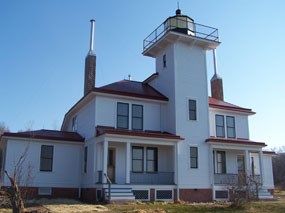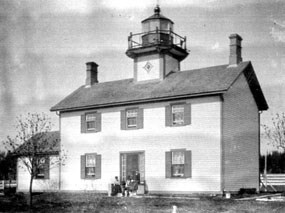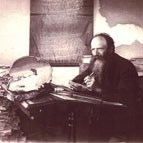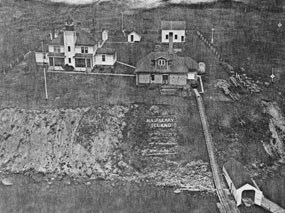
The "Showplace of the Apostle Islands" was built at the urging of Henry Rice, the influential St. Paul politician who founded the city of Bayfield. A light on Raspberry Island would help mark the approach to the new port. Support from shipping interests added weight to Rice's proposal, and in 1859 President Buchanan signed an order reserving the entire island for lighthouse use. Construction of the lighthouse began about two years later, and the structure was nearly ready for use by the end of 1862. Only one problem delayed the station's entry into service: the lantern's lens had not yet arrived. Lighthouse lenses are highly specialized optics, designed to focus the light from a small lamp into a beam that can be seen many miles across the water. The lens for the Raspberry lantern was crafted in France and took months to make its way over the ocean and across half a continent. It was not until mid-July of 1863 that the lens was installed and the light station officially began operation. 
The lighthouse that entered service during the Civil War appeared substantially different from the structure that stands on Raspberry Island today. As originally built, the Raspberry lighthouse was a boxy, two-bedroom house with a shed at one side containing the kitchen. Rising from the center of the roof was a short tower that supported the lantern. The small lighthouse served well enough for one keeper and his family, but tending the lamp without an assistant keeper was a taxing, seven-days-a-week job. A married keeper could rely on his wife for help, and Annie Larsen, wife of early keeper Louis Larsen, was actually appointed assistant keeper and paid for her efforts during their eleven-year stay at Raspberry. Mary Snow, wife of Larsen's successor Seth Snow, benefited from a similar arrangement. When Francis Jacker took over the post from Snow, however, he left his large family home at their farm. Before long, he found himself wishing for help. The work was hard: "Proper surveillance of the revolving apparatus during the long nights of the fall when frequent windings are required, is exhausting," he wrote in his log. Not only that, the situation was dangerous: "In case of an emergency, no assistance is available on the island," he added. 
Jacker's worst fears nearly came true in September, 1887. Attempting to move the station's small sailboat to a sheltered spot in the face of a rising storm, he was blown off course and shipwrecked on nearby Oak Island. He spent nearly three days, cold, hungry, and forlorn on the uninhabited island. Certain that he was doomed to perish of starvation, he was elated when a small boat approached the shore. His wife had decided to pay him a visit, and horrified to find her husband missing, organized a search. Francis Jacker's close call on Oak Island convinced his superiors that there was a genuine need for an assistant keeper at the Raspberry light, and shortly afterward he was able to hire his son, Edward, as assistant keeper. About a decade later, the station's complement increased again, with the establishment of a second assistant keeper's position. With continuing expansion in shipping traffic on Lake Superior, demand rose for a fog signal at Raspberry Island. State-of-the-art technology called for a coal-fired steam whistle, and such equipment demanded extra personnel to share the workload. In 1903, the current fog signal building was constructed, and a second assistant authorized. 
The little lighthouse was hardly adequate for three keepers and their family members, so in 1906, the Lighthouse Service remodeled the building from the ground up. Portions of the old structure were incorporated into the new building, but final result was a lighthouse that was much larger and more imposing than the original. The new lighthouse was occupied until 1947, when the light was converted to automatic operation. The lens remained in the tower until 1957, when the Coast Guard replaced it with a battery-operated beacon mounted on a pole in front of the lighthouse. Today, visitors can see the original Raspberry Island lens on display at the Wisconsin State Historical Society Museum on Madeline Island. While the lighthouse we see on Raspberry Island appears much the same as it did in 1906, the surrounding setting has changed substantially. When the lighthouse was built, the surrounding area was cleared of trees so that ships would have a clear view of the beacon. Photos taken as recently as the 1940s show an open area of several acres around the station. Today, forest has encroached upon the site, and only a portion of the original clearing remains. More ominously, the bluff in front of the lighthouse has suffered severe erosion. The steep clay banks face the force of Lake Superior at their base, while the upper sections are subject to "slumping," or collapse. Despite some efforts at erosion control in the 1980s, engineers warn that the receding bank could threaten the light station structures in as little as ten years. Fortunately, Congress has acted to protect the historic treasure known as the Raspberry Island lighthouse. Funds were appropriated to institute erosion control measures that will combine construction of a seawall at the base of the bluff, regrading the slope to a stable angle, drainage improvement, and planting vegetation. During the summer and fall of 2002, visitors to Raspberry Island were able to see the work in progress. By the end of October, more than half the project was complete. Work resumed in the spring of 2003, and the project was completed in July. For more information, visit the Rasperry Island Erosion Control Project page. Visiting the Lighthouse |
Last updated: June 28, 2021
